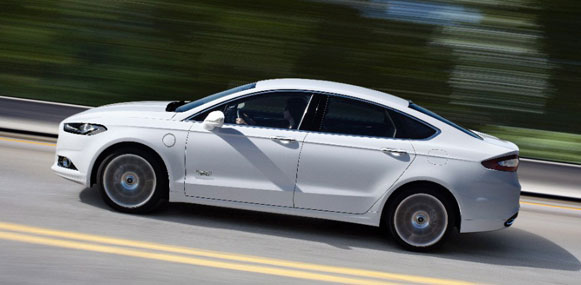Sustainability Report 2013/14
Vehicle Safety and Driver Assist Technologies
Case Study: Electrified Vehicle Safety
Anyone who owns an electrified vehicle (EV) can attest that the experience of driving an EV is essentially the same as that of a “regular” vehicle powered by an internal combustion engine. Certainly no special skills are needed to operate EVs such as hybrids, plug-in hybrids or pure battery electric vehicles.

2014 Ford Fusion Energi
Under the hood, however, EVs are, in fact, different from non-electrified vehicles in at least one important respect: they contain a battery with 300+ volts of power, whereas a regular vehicle has just one 12-volt battery.
And that means that first responders – the firefighters, police officers and emergency medical technicians who show up at the scene of a crash site – may indeed need some special knowledge and skills to be able to safely address a vehicle crash involving an EV.
“It’s not uncommon for first responders to need to update their skills and procedures in response to new technologies,” said Domenico Gabrielli, vehicle safety engineer in Ford’s Automotive Safety Office. “For instance, the advent of high-strength steels and new types of airbags required a modification of tools and procedures. Likewise, in recent years the industry has been focused on educating first responders about EVs.”
For example, we and other EV manufacturers have developed special Emergency Responder Guides for each of our electric vehicles. These guides include information on how to identify a Ford EV, locate the high-voltage system, disconnect it, and move and store the disabled vehicle, among other key tasks. Also, over the years, we have actively supported firefighters’ hands-on crash-response procedure training events, through the donation of EVs and the attendance of Ford technical personnel.
In 2010, we began working with the National Fire Protection Association (NFPA) to help reach more first responders and educate them about electric vehicles. We take part in conferences on the topic that are jointly hosted by the NFPA and the Society for Automotive Engineers (SAE). We also solicited (and incorporated) the NFPA’s feedback on our Emergency Responder Guides.
The NFPA has since developed a website for first responders, where our and other automakers’ guides are housed. Also, the NFPA developed the Emergency Field Guide – a quick reference guide that summarizes the key information that first responders need for all makes and models of EVs.
“Our comprehensive training programs – both classroom-based and online – have reached at least 35,000 first responders,” said Andrew Klock, senior project manager at the NFPA. “And the classroom programs are ‘train-the-trainer’ courses, so we know the lessons taught there are being cascaded out to many, many more first responders.”
The NFPA is also working with the Fire Protection Research Foundation, which is currently conducting a study on high-voltage battery fires and best practices for extinguishment. That work is funded in part by the Alliance of Automobile Manufacturers, of which we are a member.
Ford has also been involved in the SAE’s efforts to develop recommended standard procedures for first responders regarding EVs involved in crashes. Several Ford engineers served on the committee that developed the procedures, which were published in February 2013.
“It’s important to note,” said Gabrielli, “that automakers and government regulatory agencies have worked hard to ensure that EVs are safe in the event of a crash.” All EVs in the U.S., for instance, must comply with the National Highway Traffic Safety Administration’s regulations governing the safety of EVs. Ford also complies with similar regulations in force in other countries around the world.
Ford also has internal guidelines for EVs, governing all aspects of battery safety and crash protection. In our EVs, for example, the high-voltage battery is housed in a strong steel casing, which helps to provide protection in addition to the car’s overall safety structure. “From the beginning, our electrified vehicles are designed for safety,” said Gabrielli.
First responders have long been used to addressing the risks associated with “regular” vehicle crashes, which may involve the spillage of large quantities of flammable liquid. EVs have unique issues that first responders also need to learn how to handle. But we’re confident that the efforts of Ford and others in the industry are helping to ensure that first responders have the information they need to do their jobs safely.
Related links
This Report
External Websites
© 2014 Ford Motor Company